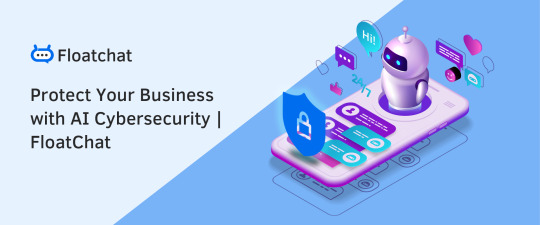#SecureWithAI
Explore tagged Tumblr posts
Text
Protect Your Business with AI Cybersecurity | FloatChat

Introduction
In today's increasingly digitized world, cyber threats loom larger than ever. As organizations become more reliant on interconnected systems and data flows, they also become more vulnerable to attacks. Recent years have seen a surge in hacking, malware, ransomware, and other cybercrimes that result in massive financial and reputational damages.
To defend against these rapidly advancing threats, traditional cybersecurity approaches are no longer sufficient. This is where revolutionary AI technologies come in - to provide next-generation protection powered by intelligence, adaptability and precision.
The Growing Menace of Cybercrime
Some key statistics highlight the severity of the cyber threat landscape:
Cybercrime is expected to inflict damages totaling $10.5 trillion annually by 2025.
A business falls victim to a ransomware attack every 14 seconds.
The average cost of a data breach now exceeds $4 million.
Phishing attacks increased by 15% in 2020 amid the remote work shift caused by the pandemic.
Hackers and cybercriminals are using increasingly sophisticated tools and tactics such as social engineering, malware infections, supply chain compromises, vulnerabilities in legacy systems, and inadequate employee training. As a result, the global cybersecurity skills shortage has reached over 3 million unfilled positions.
Why AI is a Game-Changer for Cybersecurity
Artificial intelligence refers to a range of technologies like machine learning and deep learning that enable computer systems to mimic human cognitive abilities. AI allows software to continuously learn from data to improve at specific tasks like pattern recognition, classifications, predictions, and decision making.
In cybersecurity, AI augments human analysts and security tools with the ability to:
Analyze enormous volumes of data at machine speed to detect anomalies and uncover subtle indicators of compromise. This enables real-time threat identification.
Identify zero-day threats and new attack patterns instead of just reacting to known threats. This allows organizations to keep pace with rapidly shifting attacker tactics.
Automate mundane and repetitive tasks to enable human analysts to focus on higher value investigations and response. AI is a force multiplier for security teams.
Provide explainable threat alerts instead of just signaling that something is wrong. This context helps analysts investigate and respond to alerts more efficiently.
Adapt cyber defenses dynamically as the threat landscape evolves. Self-learning algorithms ensure AI security maintains the edge over attackers.
In essence, AI allows cybersecurity to scale effectively and provides integrated intelligence that augments human capabilities.
Key Applications of AI for Cybersecurity
Some major areas where AI is revolutionizing cybersecurity include:
Malware Identification
Traditional signature-based antivirus solutions struggle to detect new strains of malware. AI algorithms overcome this by analyzing large volumes of data — metadata, binaries, behavior patterns — to accurately identify malware and prevent infections.
Insider Threat Detection
By profiling normal behavior patterns for users and assets, AI can detect anomalous actions indicative of insider risks. User behavior analytics serves as an extra security layer.
Network Security and Threat Hunting
AI algorithms perform real-time monitoring of network traffic to identify suspicious patterns like data exfiltration or command-and-control actions by bad actors. This enables early threat detection and rapid response.
Fraud Prevention
AI analyzes large amounts of customer data and activity to create robust profiles. Deviations from normal profiles are analyzed as potential fraud in real-time before damages occur.
Incident Response
AI automation assists overburdened security teams by aggregating alerts, aiding investigations, and enacting responses to confirmed threats. This reduces dwell time.
The AI Cybersecurity Platform Built by Floatchat
Floatchat is a cybersecurity vendor leveraging bleeding-edge AI research to deliver next-generation solutions. Founded by industry veterans and former NSA cyber experts in 2019, Floatchat has quickly grown to become a leader in AI-powered cybersecurity.
Floatchat’s platform integrates advanced AI that performs real-time data analysis to detect risks across an organization’s entire digital footprint - endpoints, networks, cloud, IoT devices, and users. Key capabilities include:
Robust Data Collection: Extracts and aggregates security data from diverse sources across IT infrastructure. This provides comprehensive visibility.
Continuous Behavior Modeling: Develops dynamic models customized to organization’s environments and risk profile. Flags deviations as threats.
Explainable AI: Provides contextual threat alerts with insights into reasons for raised alerts. Boosts productivity.
Dynamic Adaptability: Automatically adapts to changing attacker tactics, tech stacks, and business workflows to maintain edge.
Holistic Protection: Unified platform that secures networks, endpoints, cloud, identities, and critical data assets via AI.
Managed Services: Floatchat experts provide continuous monitoring, management and support services backed by AI/ML.
Securing Healthcare Networks with AI
The healthcare industry is highly susceptible to cyberattacks given the sensitive personal data involved. Floatchat's AI solutions are playing a key role in securing hospital networks.
For a healthcare provider in Florida, Floatchat detected early signs of a network compromise by analyzing communications patterns between medical devices and hospital servers. The threat was contained before any data could be stolen.
In another case, Floatchat AI pinpointed unauthorized data transfers initiated from the CFO's laptop indicative of insider threat. Further investigation revealed that the laptop was breached, averting a major financial fraud attempt.
The Road Ahead for Cybersecurity AI
While AI cybersecurity is already mature, there are several emerging trends and technologies poised to expand its capabilities:
Use of cybersecurity-specific AI chips like graph processors for accelerating threat detection.
Adoption of digital twin technology to model entire ecosystems and identify risks through simulation.
Predictive analytics by analyzing patterns over time to forecast the most likely emerging threats.
Improved natural language capabilities for extracting insights from security analyst notes and reports.
Conclusion
As cyber risks accelerate, AI delivers new hope for gaining an upper hand over attackers. AI provides the sophisticated detection, speed, adaptability and multifaceted protections needed against today's elusive threats. Organizations must embrace AI-powered cybersecurity platforms such as Floatchat to future-proof their defenses.
#AIForCybersecurity#CybersecurityAI#AIProtection#CyberDefense#AIinSecurity#DigitalSecurity#CyberSafety#ThreatDetection#AIResilience#SecureWithAI#TechSecurity#CyberThreats#AIforPrivacy#DataProtection#AIandCyber#CyberGuardians#AIInnovations#SecureTech#AIinProtection#CyberAwareness
0 notes